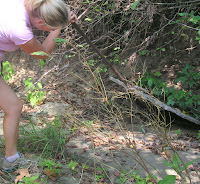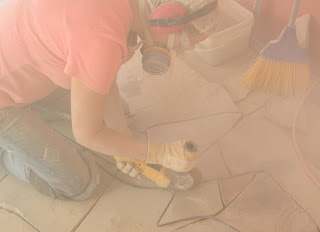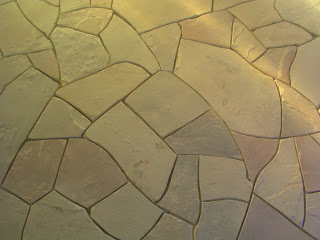
About a third of the way into the kitchen flooring project, I burned out on kitchen flooring. I made a deal with my wife "If you'll finish the kitchen floor, I'll do the plumbing." She cut and fit the remaining 2/3's of the stones for the floor, and mortared most of them down with thinset. Before she finished cutting and fitting all of the stones, we had to go on another expedition to find some more stone. The picture on the left shows what it typically looks like when we find it.

Next spring, these same stones won't be here on the creek bank... tree roots, freezing water, and gully washers break them up and move them further down stream every year. Copperheads and poison ivy are par for the course, so we try to be careful when turning over rocks for the first time.
With just a few more stones to glue down, the stonemason paid us a visit, and gave us some advice for grouting the floor. Rather than take his advice on how to best apply the grout, we hired him to grout the seams! There were several more stones to mortar to the floor, so we let him do that too! Right off the bat, he was able to get the stones a lot flatter than we were, making us look bad. (but not too bad!)

Before he started grouting the seams, the mason told us that he had one big concern. He felt that the joints were too tight to allow enough grout to get into the seams. With just a tiny amount of grout in the seams, he thought it would not be strong enough to stay put. His suggestion... grind out the seams with our angle grinder, using a wider diamond encrusted masonary blade. A week earlier, my wife had worn out the first set of motor brushes in our angle grinder... fortunately I had ordered another set of brushes and they showed up before the stone mason began this next step. (in the mean time I had filed off the limit stops on the motor brushes, to get a few more hours of life out of them!)
The stone mason has been grinding most of the joints, but that's my wife in the first picture grinding some of the joints while he's gone. This is a super dusty job. The results are nothing short of amazing, and the joints are very consistent. Below is a before and after picture of the flagstone flooring. No doubt, the stone mason's suggestion will give us a more durable and better looking floor.


By the way... all of these stones were cut and trimmed with solar power!

